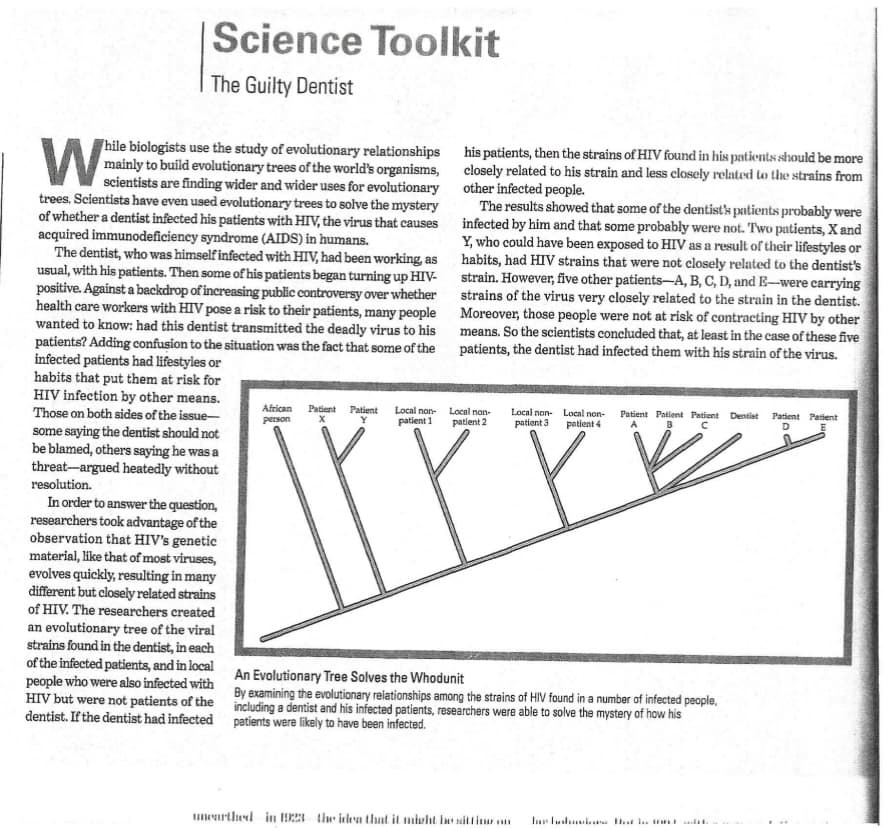Read the Guilty dentist information. Then use your understanding to answer the following question: How does the information affect our everyday life?
Read the Guilty dentist information. Then use your understanding to answer the following question: How does the information affect our everyday life?
Human Anatomy & Physiology (11th Edition)
11th Edition
ISBN:9780134580999
Author:Elaine N. Marieb, Katja N. Hoehn
Publisher:Elaine N. Marieb, Katja N. Hoehn
Chapter1: The Human Body: An Orientation
Section: Chapter Questions
Problem 1RQ: The correct sequence of levels forming the structural hierarchy is A. (a) organ, organ system,...
Related questions
Question
Read the Guilty dentist information. Then use your understanding to answer the following question:
How does the information affect our everyday life?

Transcribed Image Text:Science Toolkit
The Guilty Dentist
W
hile biologists use the study of evolutionary relationships
mainly to build evolutionary trees of the world's organisms,
scientists are finding wider and wider uses for evolutionary
trees. Scientists have even used evolutionary trees to solve the mystery
of whether a dentist infected his patients with HIV, the virus that causes
acquired immunodeficiency syndrome (AIDS) in humans.
The dentist, who was himself infected with HIV, had been working, as
usual, with his patients. Then some of his patients began turning up HIV-
positive. Against a backdrop of increasing public controversy over whether
health care workers with HIV pose a risk to their patients, many people
wanted to know: had this dentist transmitted the deadly virus to his
patients? Adding confusion to the situation was the fact that some of the
infected patients had lifestyles or
habits that put them at risk for
HIV infection by other means.
Those on both sides of the issue-
some saying the dentist should not
be blamed, others saying he was a
threat-argued heatedly without
resolution.
In order to answer the question,
researchers took advantage of the
observation that HIV's genetic
material, like that of most viruses,
evolves quickly, resulting in many
different but closely related strains
of HIV. The researchers created
an evolutionary tree of the viral
strains found in the dentist, in each
of the infected patients, and in local
people who were also infected with
HIV but were not patients of the
dentist. If the dentist had infected
African Patient
person X
Patient Local non-
Y patient 1
his patients, then the strains of HIV found in his patients should be more
closely related to his strain and less closely related to the strains from
other infected people.
The results showed that some of the dentist's patients probably were
infected by him and that some probably were not. Two patients, X and
Y, who could have been exposed to HIV as a result of their lifestyles or
habits, had HIV strains that were not closely related to the dentist's
strain. However, five other patients-A, B, C, D, and E-were carrying
strains of the virus very closely related to the strain in the dentist.
Moreover, those people were not at risk of contracting HIV by other
means. So the scientists concluded that, at least in the case of these five
patients, the dentist had infected them with his strain of the virus.
Local non-
patient 2
Local non- Local non-
patient 3
patient 4
Patient Patient Patient Dentist
A
C
An Evolutionary Tree Solves the Whodunit
By examining the evolutionary relationships among the strains of HIV found in a number of infected people,
including a dentist and his infected patients, researchers were able to solve the mystery of how his
patients were likely to have been infected.
unearthed in 1923 the idea that it might be sittin las lushes that lett
Patient Patient
Expert Solution
This question has been solved!
Explore an expertly crafted, step-by-step solution for a thorough understanding of key concepts.
Step by step
Solved in 2 steps

Knowledge Booster
Learn more about
Need a deep-dive on the concept behind this application? Look no further. Learn more about this topic, biology and related others by exploring similar questions and additional content below.Recommended textbooks for you

Human Anatomy & Physiology (11th Edition)
Biology
ISBN:
9780134580999
Author:
Elaine N. Marieb, Katja N. Hoehn
Publisher:
PEARSON

Biology 2e
Biology
ISBN:
9781947172517
Author:
Matthew Douglas, Jung Choi, Mary Ann Clark
Publisher:
OpenStax

Anatomy & Physiology
Biology
ISBN:
9781259398629
Author:
McKinley, Michael P., O'loughlin, Valerie Dean, Bidle, Theresa Stouter
Publisher:
Mcgraw Hill Education,

Human Anatomy & Physiology (11th Edition)
Biology
ISBN:
9780134580999
Author:
Elaine N. Marieb, Katja N. Hoehn
Publisher:
PEARSON

Biology 2e
Biology
ISBN:
9781947172517
Author:
Matthew Douglas, Jung Choi, Mary Ann Clark
Publisher:
OpenStax

Anatomy & Physiology
Biology
ISBN:
9781259398629
Author:
McKinley, Michael P., O'loughlin, Valerie Dean, Bidle, Theresa Stouter
Publisher:
Mcgraw Hill Education,

Molecular Biology of the Cell (Sixth Edition)
Biology
ISBN:
9780815344322
Author:
Bruce Alberts, Alexander D. Johnson, Julian Lewis, David Morgan, Martin Raff, Keith Roberts, Peter Walter
Publisher:
W. W. Norton & Company

Laboratory Manual For Human Anatomy & Physiology
Biology
ISBN:
9781260159363
Author:
Martin, Terry R., Prentice-craver, Cynthia
Publisher:
McGraw-Hill Publishing Co.

Inquiry Into Life (16th Edition)
Biology
ISBN:
9781260231700
Author:
Sylvia S. Mader, Michael Windelspecht
Publisher:
McGraw Hill Education